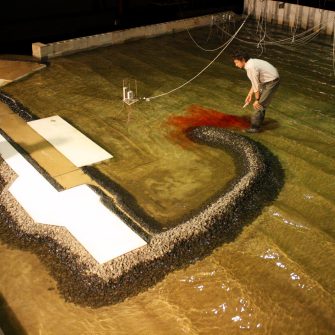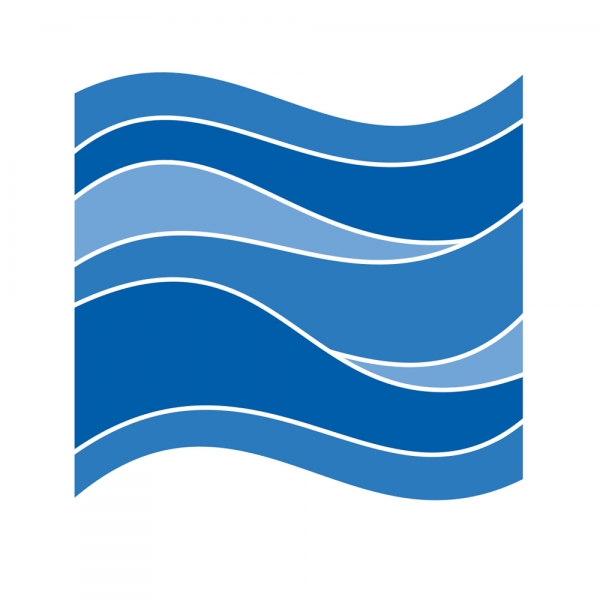Physical modelling

WRL completes coastal engineering activities through a dedicated projects team, where full time project staff undertake studies and offer expert advice to industry and government. Being a part of UNSW ensures a high calibre of personnel and facilities, creating a prestigious record of experience built up over 60 years; due to this, WRL's reputation in coastal engineering is highly regarded by our peers both in Australia and internationally.
WRL is NATA certified for Quality Assurance and guarantees that commercial activities are executed with strict regard to quality, time, budget, and in accord with authorised contractual agreements.
- Wave forces on coastal and marine structures
- Armour protection of seawalls and breakwaters
- Bed scour and movement
- Wave run-up and overtopping
- Wave reflection and absorption
- Motion and forces for floating marina units
- Water circulation and penetration
- Wave energy device testing
- Offshore breakwaters
- Shoreline changes about coastal construction
- Shoreline and wave climate effects
- Wave penetration of harbours
Physical modelling facilities
The hydraulics laboratories at WRL are the largest and most comprehensive in Australia. WRL occupies 3.8 ha of land immediately downstream of Manly Dam, and has 4 fully equipped laboratories for research and specialist consulting studies. The laboratories contain a variety of standard facilities in addition to open space, which is used for project specific construction of large scale physical models. The facilities typically used for coastal physical modelling investigations include:
All wave flumes and the wave basin can be operated with monochromatic or irregular waves, defined by spectral or time series wave parameters, or by a pre-recorded wave signal. WRL has instrumentation to measure wave properties such as height and period, and also to measure wave induced force and pressure loading and overtopping. Wave generation, data recording, and data analysis is undertaken using the GEDAP/NDAC software package.
WRL has an extensive collection of model concrete armour units that can be used for armour stability testing, and regularly has armour units produced for specific project requirements.
Example projects
-
WRL were commissioned by AW Maritime on behalf of the Royal Yacht Club of Victoria to undertake physical modelling of a wave screen breakwater design for a marina at Williamstown in Port Phillip Bay, Victoria. The proposed design for the marina included a breakwater enclosure formed with both full depth and partial depth wave screens constructed out of sheet pile to protect the berths from wave action. WRL designed and constructed a 1:10 scale 2d wave flume model of the proposed breakwater designs, which was configured such that the impacts of both short period wind waves and long period container ship wakes could be investigated.
-
The Department of State Development, Infrastructure and Planning (DSDIP) has decided to improve protection of a jetty berth at Clump Point from rough seas with construction of an overtopping breakwater at the site. WRL was engaged to undertake three dimensional (3D) physical modelling of the overtopping breakwater and coastal processes within the study area. The overtopping breakwater optimisation testing was targeted at optimising the overall breakwater size (length, crest level, crest width); and shape and position (side slopes, alignment and location).
-
WRL was commissioned by the Victorian Department of Environment and Primary Industries (DEPI) to undertake an investigation focused on potential upgrade solutions for the masonry seawall at Craigie Beach. The physical modelling work covered a wide range of structures, including a reinforced concrete pipe wall, a concrete blockwork wall and rock revetment, which required unique armour units specifically developed in-house for this project. The 2D flume model was used to rapidly investigate changes in revetment geometry and type of primary armour as well as provide quantitative measurements of mean overtopping rates. 3D laser scans were performed on the different structures to monitor the deformation of the structures under wave action and identified potential hot-spots in terms of localised armour damage.
-
A rock seawall is proposed for a 400 m long section of coastline in Toogoom, QLD. This new coastal protection infrastructure aims to stop the ongoing beach erosion and recession which have been observed in the last years, as well as potentially limit coastal inundation during cyclonic events. WRL was commissioned by the Fraser Coast Regional Council and Aurecon to complete two dimensional (2D) physical modelling of the proposed designs. The 2D flume model was used to investigate changes in revetment geometry and type of primary armour, allowing an optimisation of design primary armour size from 6 t to 3 t. Quantitative measurements of mean overtopping rates were also undertaken.
-
The proposed Browse LNG Development was to include LNG berthing facilities with shelter provided by an offshore breakwater, an Integrated Marine Facility (IMF) with shelter provided by a smaller, shore-attached breakwater, shipping channels and turning basins. This investigation included initial 2D and quasi-3D flume testing of preliminary structure designs, looking at revetment armour stability (Xbloc and rock), wave runup and overtopping; from which results were used to optimise the design.
Additional physical modelling was performed based on an array of vertical concrete monopiles; different configurations were tested in order to investigate the influence on wave transmission of spacing between the piles, to measure wave-induced force and pressure on the monopile structure, as well as a scour hole caused by a storm event about the toe of the monopile structure.
-
WRL was commissioned by SMEC on behalf of the Gladstone Ports Corporation, to undertake a physical modelling study of a pontoon design for a proposed tug berth marina at Gladstone. The pontoon model was custom built in-house. Specific attention was given to the modelling of the wear/impact buffers at the pontoon/pile interface in order to allow the pontoon to have the same range of motion as expected in the real world.
WRL used a combination of ultra-sonic sensors to track the motion of the pontoon (heave and roll) and submersible load cells for measuring the forces acting on the piles caused by the pontoon motion under wave attack, including analysis of impact and sustained load types. Wave transmission past the pontoon was measured by comparison of incident and transmitted wave conditions using a series of capacitance wave probes.
-
WRL was commissioned to undertake 2D physical modelling and quasi 3D physical modelling top investigate upgrade and remediation options for the Coffs Harbour Eastern Breakwater. This modelling targeted the investigation of interfacing new breakwater armouring with existing armour, including consideration of constructability in placement of new armour units. The sensitivity of achievable Hanbar armour unit placement density to the existing breakwater surface was also considered, along with the impact of placement density on average wave overtopping rates. Quasi 3D modelling was used to investigate armour transitions along the trunk of the structure to angled wave attack.
-
WRL was engaged by Parks Victoria to undertake 2D physical modelling of the Mornington Pier, located on the eastern side of Port Phillip Bay, in order to improve public safety and provide a new safe harbour behind the Pier during storm events. Results of testing allowed several improvements to the initial desktop-based design and cost-savings to the end client. Possible design limitations were able to be identified and amended.
The effect of wind on wave overtopping using several differing wave deflectors was also investigated. Onshore winds were shown to increase overtopping flows, in some cases to levels deemed dangerous to human safety. Using these results, an optimal deflector shape was identified to minimise risk to human safety in all but the most extreme storm conditions.
-
WRL was engaged to undertake 2D physical modelling of several complex wave-structure interactions for an extension of the St Kilda Southern breakwater to provide increased wave protection. The project included the modelling of a rock revetment similar to the existing breakwater and a vertical wave protection panel. The modelling focused on wave transmission through both structures, wave overtopping including the implementation of vertical wave screens and angled wave deflectors above each configuration, and wave breaking characteristics and impact forces on the vertical wave panel.
-
Oceanlinx Australia engaged WRL to undertake 2D physical modelling of its Wave Energy System. The Oceanlinx system converts the flow of air above an oscillating water column (OWC) into electrical energy via a mechanical turbine. Wave flume tests were undertaken independently on two different types of OWC designs in the 3 m wave flume at WRL. Phase 1 of testing involved the construction of a model based on the existing Oceanlinx OWC prototype design at a scale of 1:30. Testing was undertaken to compare the performance of the chamber under real water level time series, recorded on-site at a potential deployment location in Australia; and under synthetic time series. Phase 2 of testing involved the construction of four different model OWC designs tested with up to two orientations of wave attack at a scale of 1:33. Tests were undertaken to compare the performance of the chamber designs under both monochromatic and irregular wave attack.
-
WRL was commissioned to undertake 2D and 3D physical modelling of geotextile coastal management systems, which were proposed a resort at an island development in Abu Dhabi. The proposed coastal development scheme consisted of a field of low crested geotextile container breakwaters, utilised in combination with beach nourishment. This investigation included 2D flume testing at a scale of 1:25 investigating wave transmission, wave runup, and overtopping for a range of breakwater designs and recurrence interval events. The 3D wave basin modelling at a scale of 1:40 was primarily undertaken to measure nearshore wave driven currents around the breakwaters, as well as transmitted wave conditions.
-
A liquefied natural gas (LNG) export facility was proposed to be built on Barrow Island, WA. To allow construction of the LNG plant, a materials offload facility (MOF) was required to be constructed on the island, consisting of several wharves and craft landing facilities, protected by various coastal structures. WRL was engaged to undertake 2D and 3D physical modelling investigations of the perimeter revetment and other coastal structures associated with the project. The initial 2D flume testing of preliminary structure designs, looked at revetment armour stability, wave runup, and overtopping, from which the results were used to optimise the design, prior to undertaking the wave basin modelling. The 3D wave basin modelling further investigated armour stability and overtopping, as well as considered wave penetration associated with the plan layout of the various structures.

